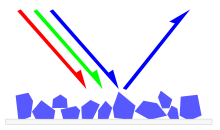Before the Industrial Revolution, the range of color available for art and decorative uses was technically limited. Most of the pigments in use were earth and mineral pigments, or pigments of biological origin. Pigments from unusual sources such as botanical materials, animal waste, insects, and mollusks were harvested and traded over long distances. Some colors were costly or impossible to mix with the range of pigments that were available. Blue and purple came to be associated with royalty because of their expense.
Biological pigments were often difficult to acquire, and the details of their production were kept secret by the manufacturers. Tyrian Purple is a pigment made from the mucus of one of several species of Murex snail. Production of Tyrian Purple for use as a fabric dye began as early as 1200 BCE by the Phoenicians, and was continued by the Greeks and Romans until 1453 CE, with the fall of Constantinople. The pigment was expensive and complex to produce, and items colored with it became associated with power and wealth. Greek historian Theopompus, writing in the 4th century BCE, reported that "purple for dyes fetched its weight in silver at Colophon [in Asia Minor].
Mineral pigments were also traded over long distances. The only way to achieve a deep rich blue was by using a semi-precious stone, lapis lazuli, to produce a pigment known as ultramarine, and the best sources of lapis were remote. Flemish painter Jan Van Eyck, working in the 15th century, did not ordinarily include blue in his paintings. To have one's portrait commissioned and painted with ultramarine blue was considered a great luxury. If a patron wanted blue, they were forced to pay extra. When Van Eyck used lapis, he never blended it with other colors. Instead he applied it in pure form, almost as a decorative glaze.[5] The prohibitive price of lapis lazuli forced artists to seek less expensive replacement pigments, both mineral (azurite, smalt) and biological (indigo).
Mechanism of PIGMENTS
Pigments appear the colors they are because they selectively reflect and absorb certain wavelengths of visible light. White light is a roughly equal mixture of the entire spectrum of visible light with a wavelength in a range from about 380 or 400 nanometres to about 760 or 780 nm. When this light encounters a pigment, parts of the spectrum are absorbed by the chemical bonds of conjugated systems and other components of the pigment. Some other wavelengths or parts of the spectrum are reflected or scattered. Most pigments are charge-transfer complexes, like transition metal compounds, with broad absorption bands that subtract most of the colors of the incident white light. The new reflected light spectrum creates the appearance of a color. Ultramarine reflects blue light, and absorbs other colors. Pigments, unlike fluorescent or phosphorescent substances, can only subtract wavelengths from the source light, never add new ones.
So a BLUE PIGMENT is BLUE because it doesn't reflect RED and GREEN light, or because it reflects all colors but the complementary of the BLUE one, which is ORANGE
A PURPLE PIGMENT is PURPLE because it absorbs all GREEN light.

- Excellent light and weather fastness
- A good baking stability that makes them suitable for automotive and other industrial paints
- High tinting strength
- Good over spray fastness when applied in paints
- Gives heat stability of around 300° C in the case of Polyolefins Plastics
- Excellent solvent resistance properties
- Easily dispersible
- Consistency and uniqueness of shades
Comparision between different PIGMENTS classes
| Property Behavior |
Inorganic Pigments |
Classical Organic Pigments |
Specialty Organic Pigments |
Organic Dyestuffs |
| Opacity | Usually high | Translucent to Transport | Very Transparent | |
| Colour Strength | Low to moderate | Considerably stronger than Inorganic Pigments | Strongest | |
| Dispersability | Usually Good: Often Abrasive | Adequate | Poor to good | Not required; Soluble |
| Heat Resistant | Usually 5000 F; Some 2000 C | 1500 C-3000 C | 2000 C- 3000 C | 2500 C- 3500 C |
| Migration resistance | Excellent | Moderate -Good | Good - Outstanding | Very Poor - good |
| Light Fastness (on a Blue scale | 6 to 8 | 2 to 6 | 6 to 8 | 2 to 7 |
| Weather resistance | Outstanding for selection | Insufficient | Excellent for Selection | Good for selection |

